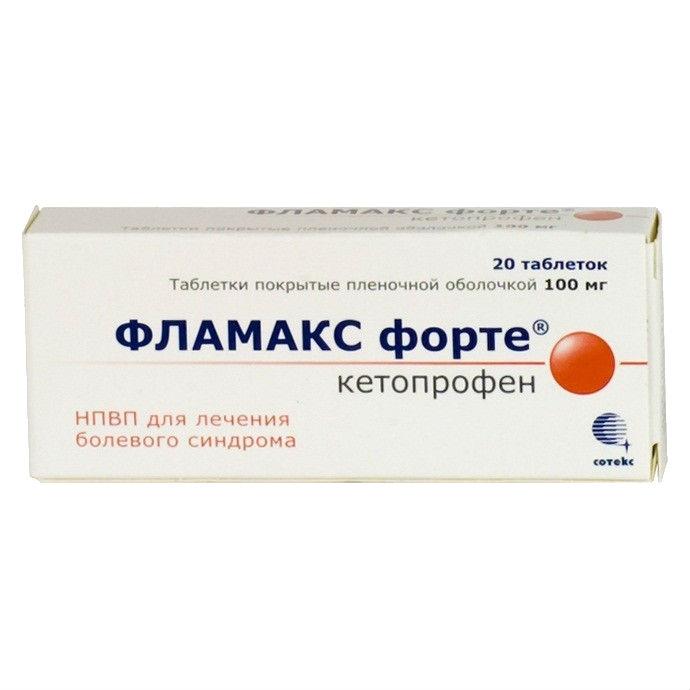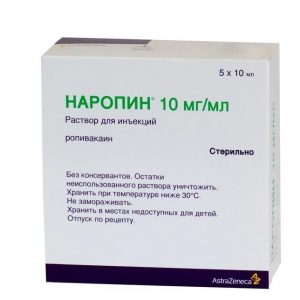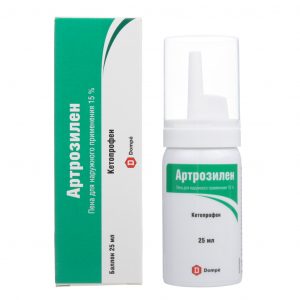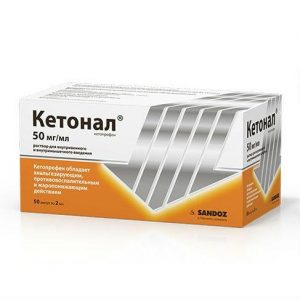Description
Release form
Film-coated tablets
Packing
In the package 100 pcs.
Indications
For the symptomatic treatment of pain and inflammation of various genesis of moderate intensity (does not affect the progression of the disease): inflammatory and degenerative diseases of the musculoskeletal system: rheumatoid, psoriatic, juvenile chronic arthritis, ankylosing spondylitis (ankylosing spondylitis, ankylosing spondylitis, under anemia, ankylosing spondylitis) soft tissue damage, osteoarthritis of the peripheral joints and spine (including with radicular syndrome)
lumbago, sciatica
neuralgia
migraine
algodismenorea
inflammatory processes of the pelvic organs, including adnexitis
post-traumatic pain syndrome, accompanied by inflammation
postoperative pain
toothache
pain syndrome in cancer.
Contraindications
hypersensitivity (including other NSAIDs or auxiliary components)
erosive and ulcerative lesions of the gastrointestinal tract in the exacerbation phase of
bleeding from the gastrointestinal tract
inflammatory bowel disease in the exacerbation phase (acute liver disease or acute liver disease) period
severe renal failure (Clcreatinin less than 30 ml / min)
progressive kidney disease
hyperkalemia
complete or incomplete combination bronchial asthma, recurrent nasal polyposis and paranasal sinuses and intolerance to acetylsalicylic acid or drugihNPVS (in t.ch.v anamnesis)
hemodyscrasia, hemostatic disorders (including hemophilia)
period after coronary artery bypass grafting
age up to 15 years.
With caution: bronchial asthma, factors that increase toxicity to the gastrointestinal tract – alcoholism and cholecystitis, chronic heart failure, edematous syndrome, hypertension, impaired renal function, cholestasis, sepsis, simultaneous use with other NSAIDs, old age (over 65), pregnancy (I II trimester) coronary heart disease cerebrovascular disease dyslipidemia / hyperlipidemia diabetes mellitus peripheral artery disease smoking chronic renal failure (creatinine Cl 30 60 ml / min) history of gastrointestinal ulcer development evidence of Helicobacter pylori infection long-term use severe somatic diseases concomitant therapy with the following drugs – anticoagulants (including warfarin), antiplatelet agents (including acetylsalicylic acid, cl pidogrel), SSRIs (including citalopram, fluoxetine, paroxetine, sertraline), corticosteroids (including prednisolone). To reduce the risk of adverse events from the gastrointestinal tract, the minimum effective dose should be used with the minimum possible short course.
Use during pregnancy and lactation
Use of the drug Flamax Forte in the III trimester of pregnancy and during breastfeeding is contraindicated (you should refuse to feed for the period of use of the drug).
Use in the first and second trimesters of pregnancy is allowed if the potential benefit to the mother outweighs the potential risk to the fetus.
Composition
1 film-coated tablet contains 100 mg of ketoprofen
Excipients: lactose monohydrate, rice starch, croscarmellose sodium, povidone, microcrystalline cellulose, magnesium stearate, sodium lauryl sulfol sulfate, sodium lauryl sulfol sulfate, sodium lauryl sulfolate dioxide brilliant blue.
Dosage and administration
Inside, with meals.
Adults – 1 tablet. 2-3 times a day (every 8 hours).
The maximum daily dose is 300 mg.
Side effects of
In clinical trials, the following side effects were noted (possibly associated with the use of ketoprofen):
From the digestive tract: dyspepsia (11%) 3 9% – nausea, abdominal pain, diarrhea / constipation, flatulence> 1% – anorexia, vomiting, stomatitis From the nervous system and sensory organs: 3 9% – headache, agitation (including insomnia, nervousness, unusual dreams)> 1% – dizziness, depression of the central nervous system (in including drowsiness, malaise), tinnitus, visual impairment
From the cardiovascular system and blood (hematopoiesis, hemostasis): From the respiratory system:> 1% – dyspnea, hemoptysis, nosebleed, pharyngitis, rhinitis, bronchospasm, laryngeal edema.
From the genitourinary system: 3 9% – impaired renal function (edema, increased blood urea nitrogen)> 1% – symptoms and signs of urinary tract irritation From the skin:> 1% – rash, alopecia, eczema, pruritis, urticaria , bullous rash, exfoliative dermatitis, photosensitivity, skin discoloration, onycholysis, toxic epidermal necrolysis, erythema multiforme, Stevens-Johnson syndrome.
On the part of the sensory organs: noise or ringing in the ears, blurred visual perception, conjunctivitis, dry eyes, eye pain, conjunctival hyperemia, hearing loss, vertigo.
From the CCC: increased blood pressure, tachycardia.
From the hemopoietic organs: agranulocytosis, anemia, hemolytic anemia, thrombocytopenia, leukopenia.
From the urinary system: edematous syndrome, cystitis, urethritis, impaired renal function, interstitial nephritis, nephrotic syndrome, hematuria.
Allergic reactions: skin rash (including erythematous, urticaria), skin itching, rhinitis, angioedema, bronchospasm, exfoliative dermatitis, anaphylactic shock.
Other: increased sweating, hemoptysis, nosebleeds, myalgia, muscle twitching, shortness of breath, thirst, photosensitivity with prolonged use in large doses – vaginal bleeding.
Drug Interaction
With the use of Flamax and “loop” diuretics, the nephrotoxic effect of both drugs is enhanced.
Reduces the effectiveness of uricosuric drugs, enhances the action of anticoagulants, antiplatelet agents, fibrinolytics, ethanol, side effects of glucocorticosteroids and mineralocorticosteroids, estrogens reduces the effectiveness of antihypertensive drugs and diuretics.
Concomitant use with other NSAIDs, glucocorticosteroids, ethanol, corticotropin can lead to ulcer formation and gastrointestinal bleeding, and increase the risk of kidney function. Concomitant use with oral anticoagulants, heparin, thrombolytics, antiplatelet agents, cefaperazone, cefamandol and cefotethan increases the risk of bleeding.
Increases hypoglycemic action of insulin and oral hypoglycemic drugs (dose adjustment is required). Inductors of microsomal oxidation in the liver (phenytoin, ethanol, barbiturates, rifampicin, phenylbutazone, tricyclic antidepressants) increase the production of hydroxylated active metabolites.
Co-administration with sodium valproate results in decreased platelet aggregation.
Increases plasma concentration of verapamil and nifedipine, lithium drugs, methotrexate.
Antacids and cholestyramine reduce absorption.
Increases the hematotoxicity of myelotoxic drugs.
Do not mix Flamax and tramadol in one vial to avoid sediment.
Overdose
Overdose has not been reported.
Symptoms: dizziness, vomiting, headache, shortness of breath, abdominal pain, bleeding, liver and kidney dysfunction may occur.
Treatment: symptomatic.
Storage conditions
Store at a temperature not exceeding 25 ° C.
The Expiration of
is 3 years.
The active substance
Ketoprofen
Dosage form
dosage form
tablets




